Unpretentious tomato "Marusya" with excellent taste: we grow it ourselves and enjoy the harvest
We present to your attention a variety of tomatoes with the original Russian name Marusya. The culture is unpretentious in care - even a lazy person will get a decent harvest. But the most important advantage lies in the unusual fruits in the form of cream. They are not only versatile in cooking, but also have won primacy in the sales markets. Also, ripe tomatoes are high in fiber, vitamin C and many micro- and macroelements, which help improve intestinal motility.
The content of the article
Characteristics and description of the variety
The tomato variety Marusya was bred by Russian breeders and entered into the State Register in 2007. Recommended for breeding in open ground and in closed structures. Easily tolerates lack of moisture and heat.
Distinctive features
A type determinant, standard, compact, height 50-75 cm. The foliage is dense, the leaves are bright green. The variety is distinguished by its ability to set fruits even in the most unfavorable conditions, such as a sharp drop in temperature or drought.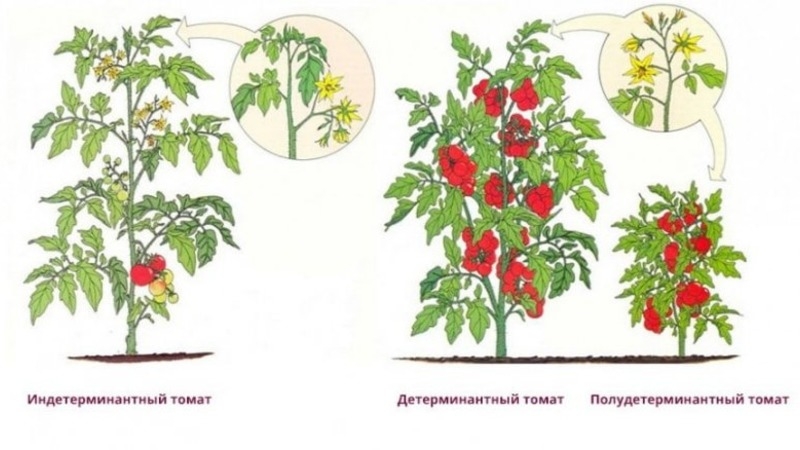
reference! In determinant plants, after the formation of the main stem, growth stops.
The yield is high, from 1 sq. m, 6-7.5 kg are harvested, provided that 4-5 seedlings are planted per 1 sq. m.
The variety is medium early, from the moment of sowing the seeds to full ripening it takes 105 - 110 days.
Differs in high resistance to dangerous diseases, for example: verticillosis and fusarium. The resistance to late blight is average.
The culture requires mandatory pinching, since this procedure affects the quantitative indicator of fruiting. With a moderate and systematic removal of stepchildren, it is possible to increase the yield to maximum indicators.
Fruit characteristics
Average weight 80-100 g, elongated shape, like cream, bright red color... A cluster of ripe tomatoes resembles a large bunch of grapes. The taste is excellent, sweet with a subtle sourness characteristic of tomatoes. Seed chambers 2-3, many seeds. The skin is firm, but not thick, but nevertheless perfectly protects ripe vegetables from cracking.
The purpose is universal: they are used fresh for preparing various dishes and for winter preparations. Vegetables are processed into tomato products for the preparation of juices, pasta, ketchup, adjika.
Ripe vegetables retain their presentation during long-term storage and can withstand transportation over various distances. This variety can often be found on sale not only in the market, but also in large chain stores.
The photo shows the Maroussia tomatoes.
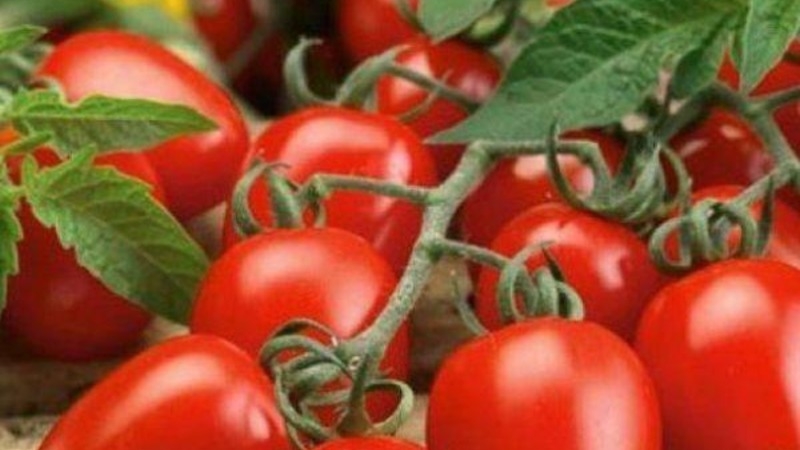
How to grow seedlings
Sowing seeds for seedlings begins 60-65 days before planting in the ground. Sowing dates depend on subsequent growing conditions. Tomatoes are planted in a greenhouse 2 weeks earlier than in open beds.
Seed preparation
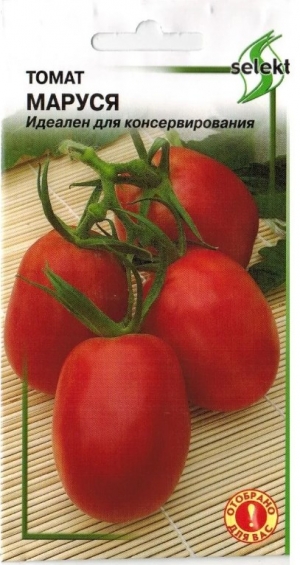 Before sowing, the grain must be prepared for further growth. First, viable specimens are selected by careful examination for damage. Then they are dipped in saline solution for 10 minutes, thereby determining whether they are hollow inside or not.
Before sowing, the grain must be prepared for further growth. First, viable specimens are selected by careful examination for damage. Then they are dipped in saline solution for 10 minutes, thereby determining whether they are hollow inside or not.
Floated to the surface are not suitable for landing.After the selection of viable seeds, they are disinfected in a solution of purple potassium permanganate.
To do this, the grains are placed in a gauze bag and dipped in a glass with potassium permanganate for 20 minutes. After disinfection, the seed is washed with running water and dried.
To improve germination, the grains are soaked in a growth stimulator for 10-12 hours. Swollen seeds can be sown in the ground.
reference! Aloe juice is used as a growth stimulant. It not only improves germination, but also protects the seed from fungal infections.
Capacity and soil
The soil is prepared from garden soil, compost and river sand in a ratio of 2: 2: 1, thoroughly mixing all the components. The prepared mixture for disinfection is spilled with a hot solution of potassium permanganate or steamed in the oven for 15 minutes at a temperature of 60 degrees.
The cooled soil is laid out in planting containers, filling them in half. In the future, as the seedlings grow, the remaining soil is added to the container, thereby providing additional receipt of nutrients.
reference! Instead of river sand, coconut fibers are added to the soil, which, like sand, act as a baking powder.
Seeds are sown in a common wooden box or in individual containers, for example, plastic and peat cups. It is much more convenient to plant in a separate container, since in the future many difficulties in care can be avoided.
Sowing
The planting material is laid in grooves 2 cm deep and 3 cm apart from each other. Sprinkle on top with earth, level and slightly moisten with warm, settled water using a spray bottle.
Important! If the seeds are sown shallowly, they will germinate along with the shell, which will subsequently cause growth retardation.
The seeded containers are covered with foil to create a greenhouse effect and left in a bright and warm room at a temperature of 24-26 degrees. If the temperature in the room is less than +16, there will be no shoots: the seeds will disappear in the ground.
Further care of seedlings
When shoots appear, the film is removed, and the containers are moved to a more illuminated place, on the windowsill. The duration of daylight hours should be at least 13 hours. If there is a lack of natural light, they are supplemented with fluorescent lamps.
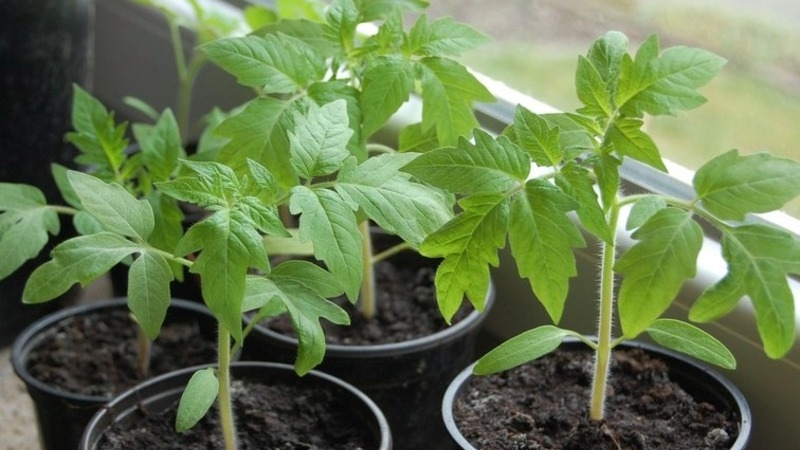 At this point, it is necessary to control the condition of the soil, preventing it from drying out. Young roots are so weak that a lack of moisture will destroy the seedlings. Water sparingly, without flooding the sprouts, with warm, settled water along the edge of the nursery with a shallow watering can. After watering, the soil is shallowly loosened with a wooden stick or ordinary fork.
At this point, it is necessary to control the condition of the soil, preventing it from drying out. Young roots are so weak that a lack of moisture will destroy the seedlings. Water sparingly, without flooding the sprouts, with warm, settled water along the edge of the nursery with a shallow watering can. After watering, the soil is shallowly loosened with a wooden stick or ordinary fork.
When 2 true leaves appear, the seedlings are dived, seated in separate containers. The picking procedure is to remove the main root by one third. The pick helps to strengthen the root system and build up lateral roots. During this procedure, I leave the stronger plants, and the weak ones are utilized.
reference! Growing seedlings in individual containers excludes picking.
2 weeks before planting, the seedlings begin to harden. This procedure is mandatory for tomato. Otherwise, it will not grow for a long time in the open field. For hardening, the seedlings are taken outside for 1 hour in the daytime at a temperature of at least 16-17 degrees, gradually increasing the time spent outdoors up to 12 hours. At the same time, the night temperature in the room is reduced to 13-12 degrees.
1 week before transplanting, the seedlings are fed with a full complex fertilizer, which contains potassium and phosphorus for better development, since the bushes do not show active growth during the seedling period.
How to grow tomatoes
After 2 months at home, the seedlings are ready for planting in the ground. At the time of transplantation, there are at least 6-7 true leaves on the bushes, a strong stem and a developed root system.
Landing
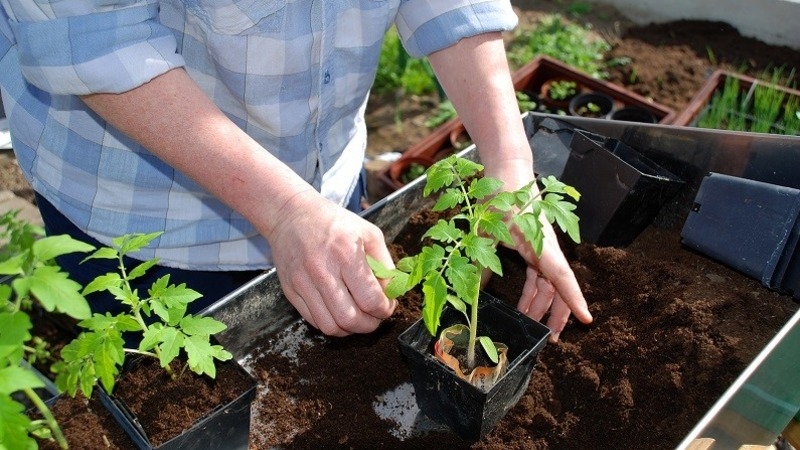
The soil is prepared 10 days before transplanting.It is dug up, loosened and a bucket of compost and 1 glass of wood ash per 1 sq. m.
Seedlings are planted in shallow holes in the morning or evening. Planting pattern: 40 cm - distance between seedlings, 60 cm - between rows. For 1 sq. m place 5 - 6 plants. If the bed is in a very sunny place, the seedlings are shaded for the first days. So they will grow faster and will not get burned.
Further care of tomato Marusya
Regular watering is established as the seedlings adapt to new conditions. Watered once a week under the root with warm, settled water. Since culture is subject late blight, fungicide "Fitosporin" is added to watering (1 tablespoon per 10 liters of water). The preparation additionally protects young plants from fungal spores.
After watering, the soil is loosened, removing weeds with roots. To retain moisture in the beds, they are mulched with peat or straw. Until the plants have grown stronger, it is important not to flood the soil, since waterlogging will negatively affect the root system and there is a possibility of the risk of developing diseases. Do not forget that tomato tolerates drought well, much better than high humidity.
2 weeks after transplanting, the seedlings are fed with a fertilizer containing mainly potassium and phosphorus. Such feeding is carried out 1 time in 2 weeks. 2 weeks before the beginning of fruiting, the plants are fed with organic matter, for example, bird droppings in a ratio of 1:15.
Features in care and possible difficulties
Step sons culture without fail: the development of unnecessary shoots threatens to reduce yields. Remove all stepsons under the first flower brush. If the crown of a tomato is thick and lush, it is thinned out. The pinching procedure is carried out in the morning, treating the cut sites with a weak solution of potassium permanganate to prevent infection.
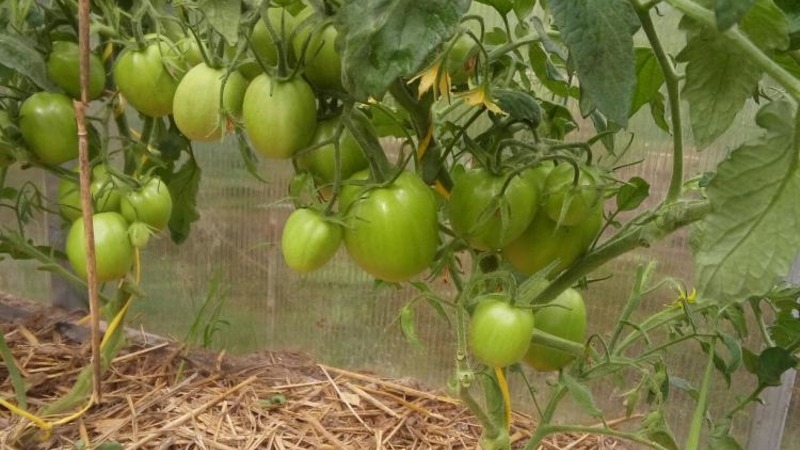
Despite the small growth, the bushes need timely garter... The fruits ripen in whole clusters, like bunches of grapes, and the bushes cannot support the weight of the ripe fruits.
Next to each plant, a wooden or metal support is installed, to which the stem and fruit-bearing branches are fixed. Another fixation option is a trellis garter. Supports are installed from different sides of the beds and a wire is pulled between them. Tomato branches are tied to a horizontally stretched wire with soft fabric ribbons.
Diseases and pests
The culture is distinguished by increased resistance to verticillous and fusarium leaf wilting, but it cannot resist phytophthora on its own. Therefore, it is initially necessary to carry out preventive measures to prevent the development of a fungal infection.
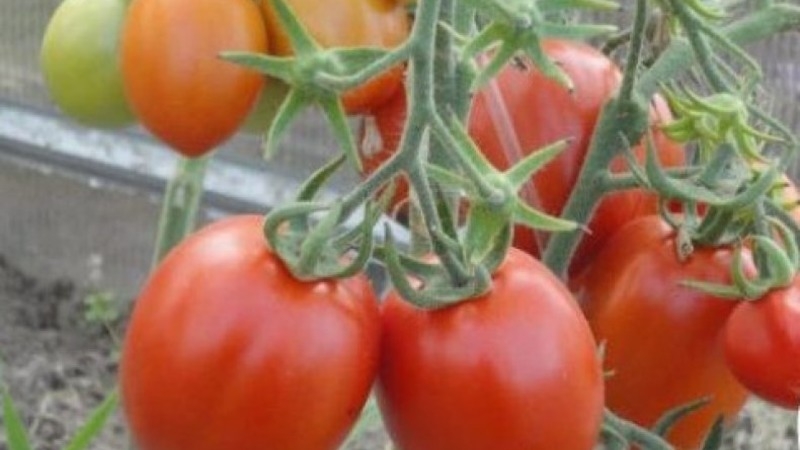
Prevention includes:
- control over the state of the soil moisture level: do not forget that tomatoes do not tolerate waterlogging;
- regular loosening;
- systematic ventilation of closed structures;
- removal of the lower leaves;
- spraying with "Fitosporin" once every 2 weeks;
- cultivation of the earth with copper sulfate.
When a fungus is damaged, plants are treated with the preparation "Khom" containing copper oxychloride. The solution is prepared by dissolving 40 g of the drug in 10 liters of water.
Important! Late blight is capable of destroying up to 75% of the crop.
To combat the Colorado potato beetle, use the Prestige remedy. After insecticide treatment, plants should be carefully inspected for remaining pests. The beetle and its larvae are collected by hand.
From slugs, the stems of the bushes are treated with soapy water. The solution is prepared from 1 piece of laundry soap dissolved in 1 bucket of water.
Tomato is saved from flying insect pests by pungent-smelling plants planted nearby.
The nuances of cultivation in the open field and in the greenhouse
In the greenhouse, the growth of plants exceeds those planted on the street and reaches up to 1 m. The bush is crowned by itself, you do not need to pinch the crown.
reference! If it ends, it ends with a flower brush and stops growing.
It is not necessary to spud the tomato, the stem will become more powerful, but the fruiting times will be postponed.
This variety of tomato is so able to adapt to adverse conditions that it is even able to survive without watering, feeding and pinching.... However, the quantitative indicator of fruiting will be significantly reduced compared to favorable conditions.
With abundant watering tomato fruits, when ripe, crack and acquire a watery taste. In addition, excess moisture provokes many diseases.
Harvesting and application of the crop
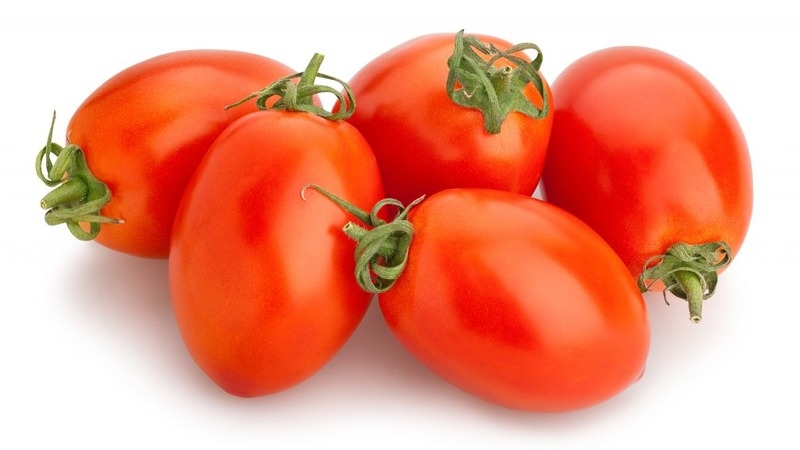
Harvesting begins in July. Vegetables ripen together, with whole brushes, so it is easy to collect them.
The use of tomatoes is universal. They are great for preparing fresh meals, a variety of snacks, pizza, sandwiches. Maroussia is considered an excellent pickling variety. Also, small tomatoes are used for whole-fruit canning and pickles.
Ripe tomatoes are processed for further preparation of ketchup, juices, adjika and pasta.
The species is distinguished by long-term storage without loss of presentation and can withstand transportation over any distance. Entrepreneurs are happy to breed a variety for sale, since there is an increased demand for tomatoes in the sales markets.
Advantages and disadvantages
The positive characteristics of tomato include:
- unpretentious care;
- the ability to set fruits in adverse conditions;
- adaptation to any climate;
- high yield;
- resistance to certain diseases;
- excellent fruit taste;
- universal purpose;
- the possibility of breeding for sale;
- high demand for ripe vegetables;
- long-term storage;
- long transportation.
Disadvantages of the view are the need for a garter and moderate pinching. But these procedures are quite simple and do not take much time.
Farmers reviews
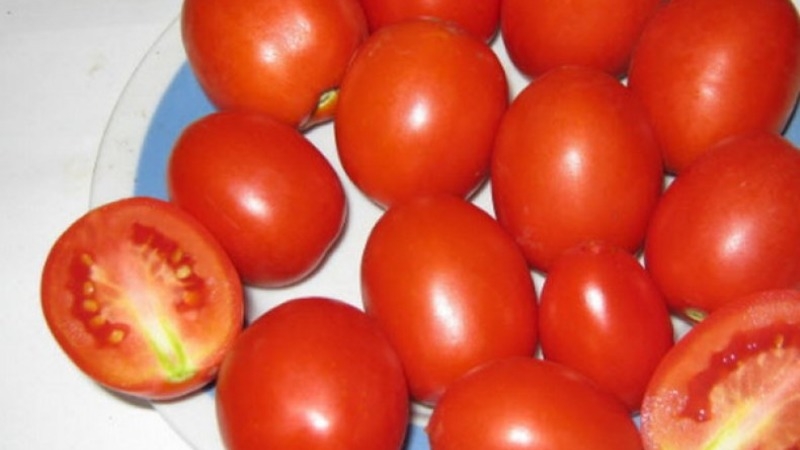
Culture reviews are eloquent and convincing. Tomato is loved for its ease of care and very decent yield indicators. In addition, many gardeners are pleased with the possibility of self-collecting seeds. Here are the opinions of gardeners:
Natalia, Syzran: "I plant the Marusya variety on open beds. I don't water it often, but there are always a lot of fruits. I really like the taste, sweet with sourness. I love to bake them with scrambled eggs and put them into winter preparations. The pickles are excellent. "
Mikhail, Nizhny Novgorod: “Excellent variety for outdoor use. The tomatoes are delicious, beautiful, in the form of cream. There are always many ovaries. The bushes are not tall, I usually do not get sick. But I carry out prophylaxis against late blight regularly. Fruiting is high, even in spite of the hot summer. "
Conclusion
Tomato Marusya is a great option for gardeners who do not want to devote much time to summer cottages. Despite its short existence in the vegetable world, it managed to regain its leading position as an amateur and industrial species.
In cooking, it is used as widely as imagination suffices. In addition, the culture is distinguished by resistance to diseases, high rates of fruiting and the ability to adapt to any, even the most unfavorable conditions. And delightful photos of cream tomatoes make you want to see them on your table.